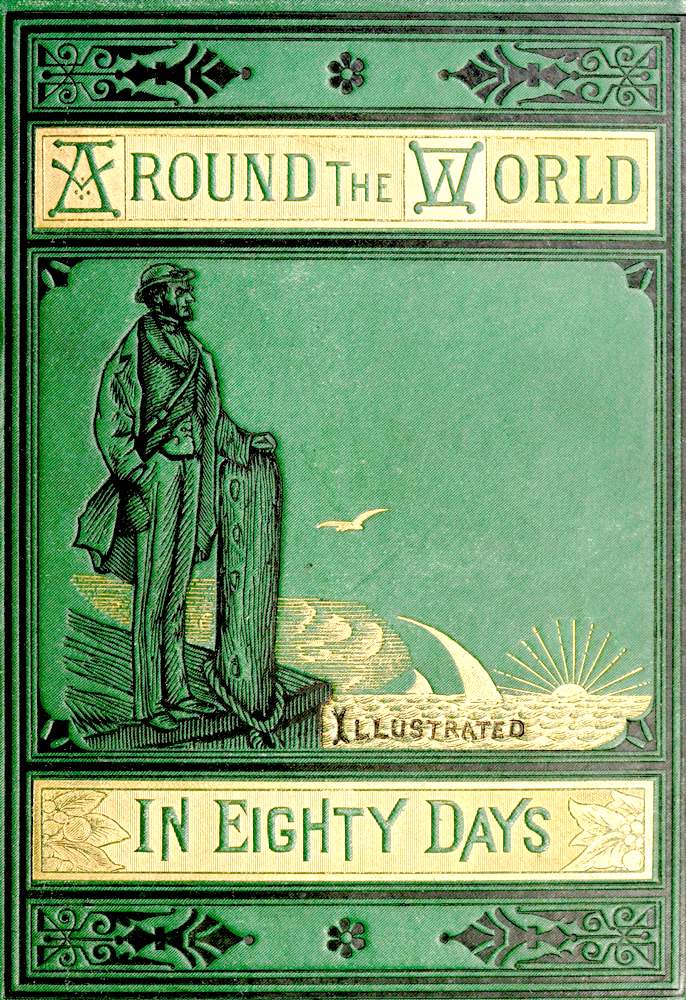|
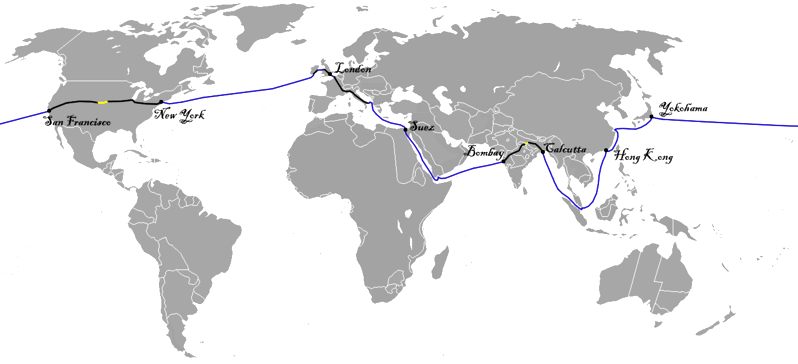
Map
of the route taken by Phileas Fogg, starting in London, then proceeding
east to Suez, Bombay, Calcutta, Hong Kong , Yokohama, San Francisco, New
York, and across the Atlantic
ocean to Ireland, then Liverpool England, and back to London. The route
planner below is for a circumnavigation on water in under 80 days, using
hydrogen, as per the author's prediction in The Mysterious Island. It
would be a major achievement if this was arranged to honor the 150th
anniversary of his publication.
<<<<
CHAPTER
IX.
IN WHICH THE RED SEA AND THE INDIAN OCEAN PROVE PROPITIOUS TO THE DESIGNS OF PHILEAS FOGG
The distance between
Suez and Aden is precisely thirteen hundred and ten miles, and the regulations of the company allow the steamers one hundred and thirty-eight hours in which to traverse it. The “Mongolia,” thanks to the vigorous exertions of the engineer, seemed likely, so rapid was her speed, to reach her destination considerably within that time. The greater part of the passengers from Brindisi were bound for India some for Bombay, others for Calcutta by way of Bombay, the nearest route thither, now that a railway crosses the Indian peninsula. Among the passengers was a number of officials and military officers of various grades, the latter being either attached to the regular British forces or commanding the Sepoy troops, and receiving high salaries ever since the central government has assumed the powers of the East India Company: for the sub-lieutenants get £280, brigadiers, £2,400, and generals of divisions, £4,000. What with the military men, a number of rich young Englishmen on their travels, and the hospitable efforts of the purser, the time passed quickly on the “Mongolia.” The best of fare was spread upon the cabin tables at breakfast, lunch, dinner, and the eight o’clock supper, and the ladies scrupulously changed their toilets twice a day; and the hours were whirled away, when the sea was tranquil, with music, dancing, and games.
But the Red Sea is full of caprice, and often boisterous, like most long and narrow gulfs. When the wind came from the African or Asian coast the “Mongolia,” with her long hull, rolled fearfully. Then the ladies speedily disappeared below; the pianos were silent; singing and dancing suddenly ceased. Yet the good ship ploughed straight on, unretarded by wind or wave, towards the straits of Bab-el-Mandeb. What was
Phileas Fogg doing all this time? It might be thought that, in his anxiety, he would be constantly watching the changes of the wind, the disorderly raging of the billows—every chance, in short, which might force the “Mongolia” to slacken her speed, and thus interrupt his journey. But, if he thought of these possibilities, he did not betray the fact by any outward sign.
Always the same impassible member of the Reform Club, whom no incident could surprise, as unvarying as the ship’s chronometers, and seldom having the curiosity even to go upon the deck, he passed through the memorable scenes of the
Red Sea with cold indifference; did not care to recognise the historic towns and villages which, along its borders, raised their picturesque outlines against the sky; and betrayed no fear of the dangers of the Arabic Gulf, which the old historians always spoke of with horror, and upon which the ancient navigators never ventured without propitiating the gods by ample sacrifices. How did this eccentric personage pass his time on the “Mongolia”? He made his four hearty meals every day, regardless of the most persistent rolling and pitching on the part of the steamer; and he played whist indefatigably, for he had found partners as enthusiastic in the game as himself. A tax-collector, on the way to his post at Goa; the Rev. Decimus Smith, returning to his parish at Bombay; and a brigadier-general of the English army, who was about to rejoin his brigade at Benares, made up the party, and, with Mr. Fogg, played whist by the hour together in absorbing silence.
As for Passepartout, he, too, had escaped sea-sickness, and took his meals conscientiously in the forward cabin. He rather enjoyed the voyage, for he was well fed and well lodged, took a great interest in the scenes through which they were passing, and consoled himself with the delusion that his master’s whim would end at Bombay. He was pleased, on the day after leaving Suez, to find on deck the obliging person with whom he had walked and chatted on the quays.
“If I am not mistaken,” said he, approaching this person, with his most amiable smile, “you are the gentleman who so kindly volunteered to guide me at Suez?”
“Ah! I quite recognise you. You are the servant of the strange
Englishman —”
“Just so, monsieur —”
“Fix.”
“Monsieur Fix,” resumed
Passepartout, “I’m charmed to find you on board. Where are you bound?”
“Like you, to Bombay.”
“That’s capital! Have you made this trip before?”
“Several times. I am one of the agents of the Peninsular Company.”
“Then you know India?”
“Why yes,” replied Fix, who spoke cautiously.
“A curious place, this India?”
“Oh, very curious. Mosques, minarets, temples, fakirs, pagodas, tigers, snakes, elephants! I hope you will have ample time to see the sights.”
“I hope so, Monsieur Fix. You see, a man of sound sense ought not to spend his life jumping from a steamer upon a railway train, and from a railway train upon a steamer again, pretending to make the tour of the world in eighty days! No; all these gymnastics, you may be sure, will cease at Bombay.”
“And Mr. Fogg is getting on well?” asked Fix, in the most natural tone in the world.
“Quite well, and I too. I eat like a famished ogre; it’s the sea air.”
“But I never see your master on deck.”
“Never; he hasn’t the least curiosity.”
“Do you know, Mr. Passepartout, that this pretended tour in eighty days may conceal some secret errand—perhaps a diplomatic mission?”
“Faith, Monsieur Fix, I assure you I know nothing about it, nor would I give half a crown to find out.”
After this meeting, Passepartout and Fix got into the habit of chatting together, the latter making it a point to gain the worthy man’s confidence. He frequently offered him a glass of whiskey or pale ale in the steamer bar-room, which Passepartout never failed to accept with graceful alacrity, mentally pronouncing Fix the best of good fellows.
Meanwhile the “Mongolia” was pushing forward rapidly; on the 13th, Mocha, surrounded by its ruined walls whereon date-trees were growing, was sighted, and on the mountains beyond were espied vast coffee-fields. Passepartout was ravished to behold this celebrated place, and thought that, with its circular walls and dismantled fort, it looked like an immense coffee-cup and saucer. The following night they passed through the Strait of Bab-el-Mandeb, which means in Arabic “The Bridge of Tears,” and the next day they put in at Steamer Point, north-west of Aden harbour, to take in coal. This matter of fuelling steamers is a serious one at such distances from the coal-mines; it costs the Peninsular Company some eight hundred thousand pounds a year. In these distant seas, coal is worth three or four pounds sterling a ton.
The “Mongolia” had still sixteen hundred and fifty miles to traverse before reaching Bombay, and was obliged to remain four hours at Steamer Point to coal up. But this delay, as it was foreseen, did not affect
Phileas Fogg’s programme; besides, the “Mongolia,” instead of reaching Aden on the morning of the 15th, when she was due, arrived there on the evening of the 14th, a gain of fifteen hours.
Mr. Fogg and his servant went ashore at Aden to have the passport again visaed; Fix, unobserved, followed them. The visa procured, Mr. Fogg returned on board to resume his former habits; while Passepartout, according to custom, sauntered about among the mixed population of Somalis, Banyans, Parsees, Jews, Arabs, and Europeans who comprise the twenty-five thousand inhabitants of Aden. He gazed with wonder upon the fortifications which make this place the Gibraltar of the
Indian
Ocean, and the vast cisterns where the English engineers were still at work, two thousand years after the engineers of Solomon.
“Very curious, very curious,” said Passepartout to himself, on returning to the steamer. “I see that it is by no means useless to travel, if a man wants to see something new.” At six p.m. the “Mongolia” slowly moved out of the roadstead, and was soon once more on the Indian Ocean. She had a hundred and sixty-eight hours in which to reach Bombay, and the sea was favourable, the wind being in the north-west, and all sails aiding the engine. The steamer rolled but little, the ladies, in fresh toilets, reappeared on deck, and the singing and dancing were resumed. The trip was being accomplished most successfully, and Passepartout was enchanted with the congenial companion which chance had secured him in the person of the delightful Fix. On Sunday, October 20th, towards noon, they came in sight of the Indian coast: two hours later the pilot came on board. A range of hills lay against the sky in the horizon, and soon the rows of palms which adorn Bombay came distinctly into view. The steamer entered the road formed by the islands in the bay, and at half-past four she hauled up at the quays of Bombay.
Phileas Fogg was in the act of finishing the thirty-third rubber of the voyage, and his partner and himself having, by a bold stroke, captured all thirteen of the tricks, concluded this fine campaign with a brilliant victory.
The “Mongolia” was due at Bombay on the 22nd; she arrived on the 20th. This was a gain to Phileas Fogg of two days since his departure from London, and he calmly entered the fact in the itinerary, in the column of gains.
NEXT
>>>>
CHAPTERS
1. - I. IN WHICH PHILEAS FOGG AND PASSEPARTOUT ACCEPT EACH OTHER, THE ONE AS
MASTER AND AS MAN
2. - II. IN WHICH PASSEPARTOUT IS CONVINCED THAT HE HAS AT LAST FOUND HIS IDEAL
3. - III. IN WHICH A CONVERSATION TAKES PLACE WHICH SEEMS LIKELY TO COST PHILEAS FOGG DEAR
4. - IV. IN WHICH PHILEAS FOGG ASTOUNDS
PASSEPARTOUT, HIS SERVANT
5. - V. IN WHICH A NEW SPECIES OF FUNDS, UNKNOWN TO THE MONEYED MEN, APPEARS ON ’CHANGE
6. - VI. IN WHICH FIX, THE DETECTIVE, BETRAYS A VERY NATURAL IMPATIENCE
7. - VII. WHICH ONCE MORE DEMONSTRATES THE USELESSNESS OF PASSPORTS AS AIDS TO DETECTIVES
8. - VIII. IN WHICH PASSEPARTOUT TALKS RATHER MORE, PERHAPS, THAN IS PRUDENT
9. - IX. IN WHICH THE RED SEA AND THE INDIAN OCEAN PROVE PROPITIOUS TO THE DESIGNS OF PHILEAS FOGG
10. - X. IN WHICH PASSEPARTOUT IS ONLY TOO GLAD TO GET OFF WITH THE LOSS OF HIS SHOES
11. - XI. IN WHICH PHILEAS FOGG SECURES A CURIOUS MEANS OF CONVEYANCE AT A FABULOUS PRICE
12. - XII. IN WHICH PHILEAS FOGG AND HIS COMPANIONS VENTURE ACROSS THE INDIAN FORESTS, AND WHAT ENSUED
13. - XIII. IN WHICH PASSEPARTOUT RECEIVES A NEW PROOF THAT FORTUNE FAVORS THE BRAVE
14. - XIV. FOGG DESCENDS THE LENGTH OF THE BEAUTIFUL VALLEY OF THE GANGES WITHOUT EVER THINKING OF SEEING IT
15. - XV. IN WHICH THE BAG OF BANKNOTES DISGORGES SOME THOUSANDS OF POUNDS MORE
16. - XVI. IN WHICH FIX DOES NOT SEEM TO UNDERSTAND IN THE LEAST WHAT IS SAID TO HIM
17. - XVII. SHOWING WHAT HAPPENED ON THE VOYAGE FROM SINGAPORE TO HONG KONG
18. - XVIII. IN WHICH PHILEAS FOGG, PASSEPARTOUT, AND FIX GO EACH ABOUT HIS BUSINESS
19. - XIX. IN WHICH PASSEPARTOUT TAKES A TOO GREAT INTEREST IN HIS MASTER, AND WHAT COMES OF IT
20. - XX. IN WHICH FIX COMES FACE TO FACE WITH PHILEAS FOGG
21. - XXI. IN WHICH THE MASTER OF THE “TANKADERE” RUNS GREAT RISK OF LOSING A REWARD OF TWO HUNDRED POUNDS
22. - XXII. PASSEPARTOUT DISCOVERS IT IS CONVENIENT TO HAVE MONEY IN ONE’S POCKET
AT THE ANTIPODES
23. - XXIII. IN WHICH PASSEPARTOUT’S NOSE BECOMES OUTRAGEOUSLY LONG
24. - XXIV. DURING WHICH MR. FOGG AND PARTY CROSS THE PACIFIC OCEAN
25. - XXV. IN WHICH A SLIGHT GLIMPSE IS HAD OF SAN FRANCISCO
26. - XXVI. IN WHICH PHILEAS FOGG AND PARTY TRAVEL BY THE PACIFIC RAILROAD
27. - XXVII. IN WHICH PASSEPARTOUT UNDERGOES, AT A SPEED OF 20 MPH, A COURSE OF MORMON HISTORY
28. - XXVIII. IN WHICH PASSEPARTOUT DOES NOT SUCCEED IN MAKING ANYBODY LISTEN TO REASON
29. - XXIX. IN WHICH CERTAIN INCIDENTS ARE NARRATED WHICH ARE ONLY TO BE MET WITH ON AMERICAN RAILROADS
30. - XXX. IN WHICH PHILEAS FOGG SIMPLY DOES HIS DUTY
31. - XXXI. IN WHICH FIX, THE DETECTIVE, CONSIDERABLY FURTHERS THE INTERESTS OF PHILEAS FOGG
32. - XXXII. IN WHICH PHILEAS FOGG ENGAGES IN A DIRECT STRUGGLE WITH BAD FORTUNE
33. - XXXIII. IN WHICH PHILEAS FOGG SHOWS HIMSELF EQUAL TO THE OCCASION
34. - XXXIV. IN WHICH PHILEAS FOGG AT LAST REACHES LONDON
35. - XXXV. IN WHICH PHILEAS FOGG DOES NOT HAVE TO REPEAT HIS ORDERS TO PASSEPARTOUT TWICE
36. - XXXVI. IN WHICH PHILEAS FOGG’S NAME IS ONCE MORE AT A PREMIUM ON ’CHANGE
37. - XXXVII. PHILEAS FOGG FINDS HE GAINED NOTHING BY HIS TOUR AROUND THE WORLD, UNLESS IT WERE HAPPINESS
PLOT
- AROUND
THE WORLD IN EIGHTY DAYS
The story starts in London on October 2, 1872. Phileas Fogg is a wealthy, solitary, unmarried gentleman with regular habits. The source of his wealth is not known and he lives modestly. He fires his former valet, James Forster, for bringing him shaving
water two degrees too cold. He hires as a replacement
Passepartout, a Frenchman of around 30 years of age.
Later that day in the Reform Club, he gets involved in an argument over an article in
The Daily
Telegraph, stating that with the opening of a new railway section in India, it is now possible to travel around the world in 80 days.
Fogg accepts a wager for £20,000 from his fellow club members, which he will receive if he makes it around the world in 80 days. Accompanied by his manservant
Passepartout, he leaves London by train at 8.45 p.m. on October 2, 1872, and thus is due back at the Reform Club at the same time 80 days later, on December 21.
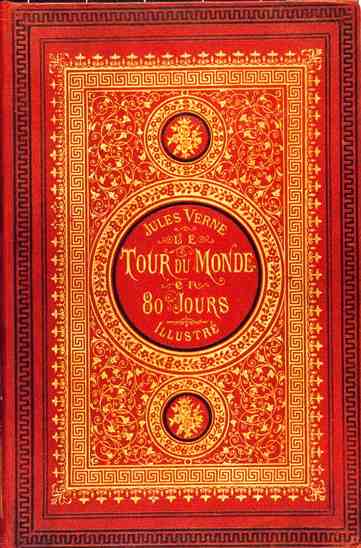
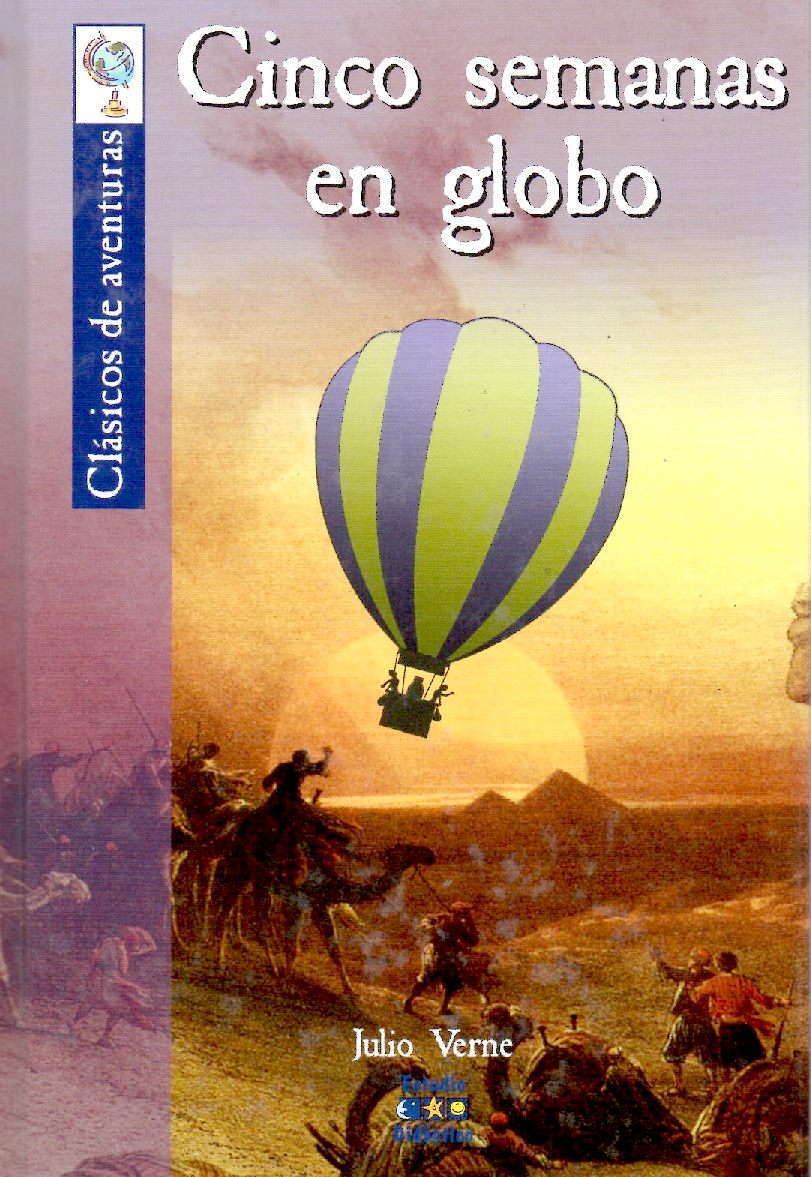
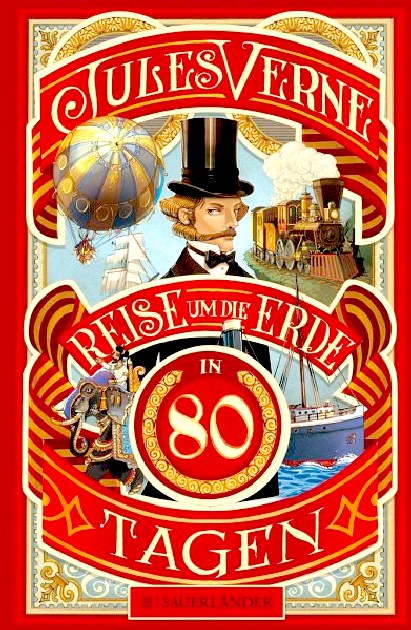
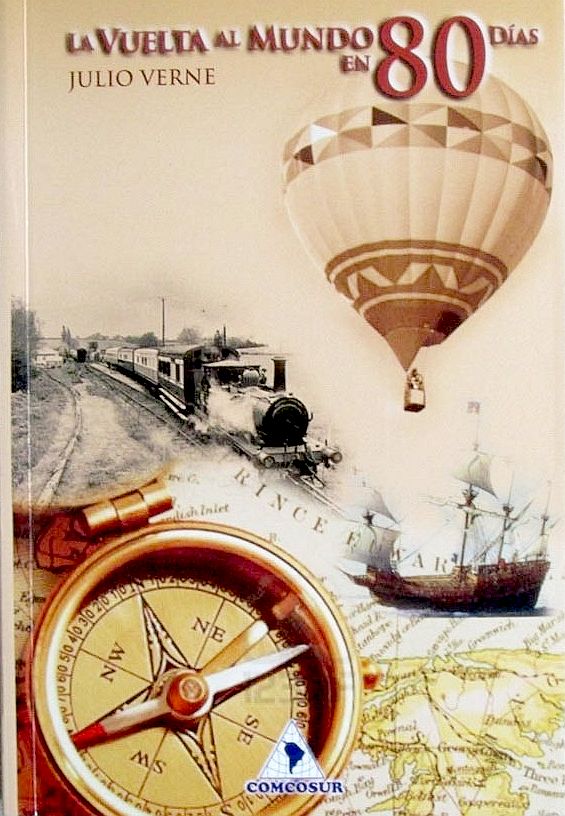

Many
of his stories today seem a little tame, as technology has caught up
with the imagination of the extraordinary French author, and Hollywood
has discovered Computer Generated Images (CGI) allowing super heroes to
grace our screens as never before. Computers are one thing that Verne
did not imagine or seek to portray.
Beginning in late 1872, the serialized version of Verne's famed Around the World in Eighty Days (Le Tour du monde en quatre-vingts jours) first appeared in print. The story of Phileas Fogg and Jean Passepartout takes readers on an adventurous global tour at a time when travel was becoming easier and alluring. In the century plus since its original debut, the work has been adapted for the theater, radio, television and film, including the classic 1956 version starring David
Niven. The TV series starring Pierce Brosnan released in 1989, runs for around 6 hours on
2 DVDs. A BBC
TV travel documentary starring Michael Palin, was also screened in
1989. A second TV series starring David Tennant was produced by the
BBC for 2021.
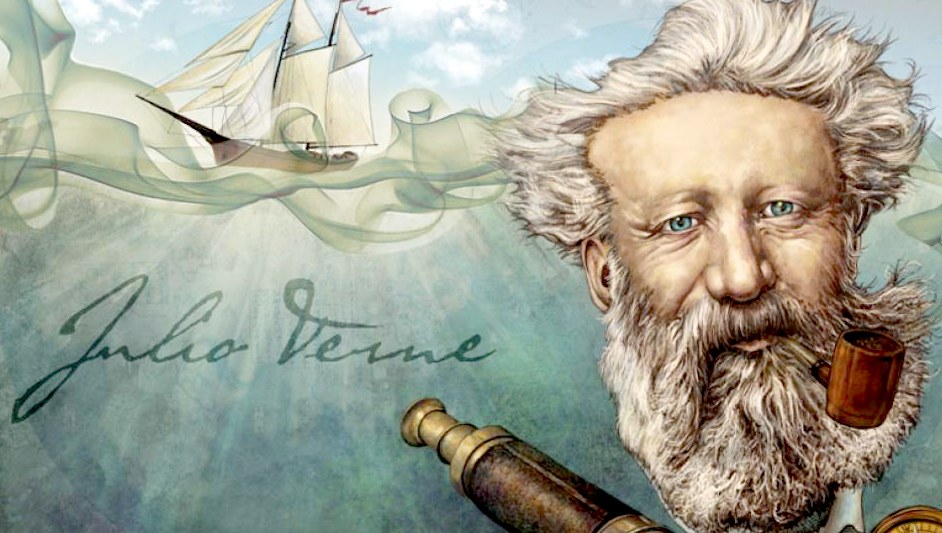
Jules
Verne is known as the Father of Science Fiction
Where
Jules Verne's suggested that it might be possible to travel Around The
World In 80 Days, we would like to extend that ethos to include
traveling in a Zero
Emission yacht (ZEWT or ZEV) driven by electric
hydro-jets? With the advent of solar power and liquid
hydrogen, it is a distinct possibility - on a scale of the wager
that the legendary Philleas Fogg entered into at the Reform Club in
1872.
|







